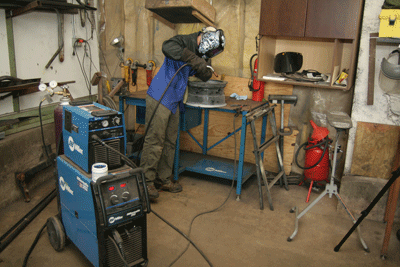
"I recommend the 30" x 60" ArcStation because it's just nice to have the extra work space," says off-road motorsports enthusiast Reon Rounds. "You might not think you're going to use the extra space, but in the long run, you'll end up using it for sure."
Think of a welding workstation as the foundation of a house. A sturdy, level and well-planned foundation promotes quick, easy and accurate construction, where a bad foundation dooms quality and efficiency from the start.
Unfortunately, too many DIY welders, small fabricators, metalworkers, farmers, ranchers and maintenance personnel start with a weak foundation. Common "make-do" welding surfaces include the garage or shop floor, saw horses, trash cans, 55-gallon drums, wooden benches, cast iron stoves, old washing machines, the welding machine itself, wobbly home-made welding tables and even ironing boards.
None of these makeshift welding surfaces promote square and in-plane fabrication. None offer good fixturing or easy clamping. Many create hazards due to flammable materials or volatile fumes. Some are subject to sudden collapse under too much weight or a lateral impact. And none facilitate smooth workflow.
Further, ergonomics and comfort are also major considerations, even for people such as Reon Rounds, a 26-year-old off-road and motorsports enthusiast.
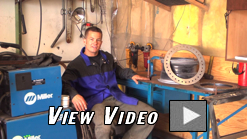
"Usually when I build anything, it would always be on the garage floor because that was the most flat, cleanest surface that I had to work on," Rounds, who welds and cuts on three trucks and a fleet of motorcycles, mopeds, three-wheelers, trailers and snowmobiles using a Millermatic® 252 MIG welding and Spectrum® 625 plasma cutter.
"When working on the floor, you're always kneeling. After a while your back starts to hurt, your knees start to hurt and it just becomes a pain. Not to mention you can't ground the floor. So whatever you're welding, you have to clamp your ground to that, which is also a pain."
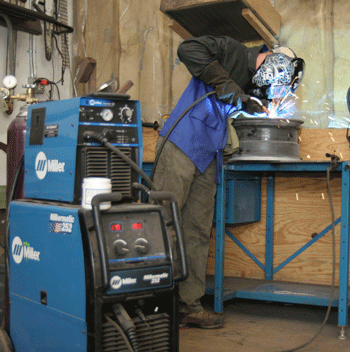
The ArcStation positions weldments about 36” off the floor,
eliminating the knee pain and lower back strain Reon Rounds
(shown here) used to experience when welding on the garage floor.
Lack of Time
Rounds welded on the garage floor for two years after buying his Millermatic 252, and his reasoning is pretty typical. "I didn't build a welding table because I just didn't have the time to be building things that aren't 100 percent necessary" for getting his vehicles ready to ride.
Jim Wagner, the owner of Zero to 60 Garage in Sherwood, Wis., also feels the time crunch.Zero to 60 specializes in the repair and restoration of cars. It works with all vintages and all brands, from Model As to Ferraris, and does everything from an oil change on a classic car to a complete nut and bolt restoration and engine rebuild. The company stays plenty busy, but success has its own complications.
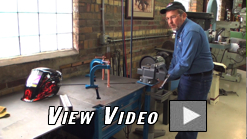
"Time is the most important commodity I have. There's never enough," says Wagner, who does most of the shop's TIG welding using Miller equipment. "Our previous welding station was built because we didn't have one. And we didn't have any time. And we didn't have any material. Probably like most weld stations, it was, 'What do we have, and what can we rig up real fast?'"
Wagner's answer was to use "a big chunk of steel with some pipes welded to it." He chronicles the faults of the welding table that got him by for several years:
"It's a little wiggly. There was no good way to level it so we'd shim the leg up. We had no good way to clamp to it. You had to clamp near the edge, and you could clamp only as far as you could reach with a C clamp. The vise that was on it was permanent. It doesn't come off, and it's always in the way. It's a little bit small. If you get a big part on here, it hangs over the edge. It was lacking in a lot of features."

"I need tools that are durable," says Reon Rounds. Rounds recently used the ArcStation to weld bead locks on these four rims. A bead lock keeps the tire on the rim even with the low air pressure required for rock crawling or driving on sand.
A Workbench for Welders
After being introduced to a workbench designed by welders and specifically built for welding-the ArcStation™ workbench from Miller Electric Mfg. Co.-both Wagner and Rounds have changed their perceptions about the need for, and value of, workbenches from a third party.
The ArcStation workbench uses a modular system based on 30" x 30" or 30" x 60" table. The top is a plate of 3/16" or 3/8" steel with the X-Pattern clamping system offered on the 3/8" top. The X-Pattern eliminates the reach problems associated with traditional tables and C clamps.
Standard features include leveling feet, a work clamp lug, lower shelf, 1/8"-thick steel tubing and cross bars for stability. X-pattern tops also include a dust tray to keep the shelves and floor clean. All ArcStation models have been tested to support up to 1,000 lbs. Accessories include:
- A weld curtain, which helps contain dust and prevents arc flash in multi-person environments.
- A quick-remove vise and mount that slides into any of the corner posts and locks with a single bolt.
- Organizational aids, such as a side shelf, tool chest with ball bearing slides and holders for tools, clamps and welding guns/torches.
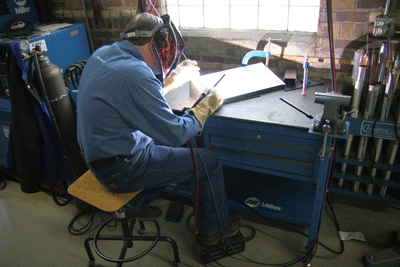
While this weldment easily fits on the 30" x 60'' ArcStation, Jim Wagner
(shown here TIG welding), really likes ArcStation's quick remove vise feature.
He can move the vise around the table or completely remove it when working
with large objects.
"When the ArcStation became available, it was such an improvement over what we had, it really was an answer to our needs," Wagner says. "Everything's at my fingertips. When I come over to weld something, I know all my equipment is here. I can quickly grab my TIG torch [off the torch holder], get my job done and get the part back on the car. Everything is where I want it, and that just solves so many issues."
Wagner and Rounds both appreciate the tool chest option, which they use to store welding specific items, such as gloves, clamps, side cutters and grinding discs. They keep organized shops, so the ArcStation fits their mentality.
Both also value the clamping versatility and benefits of the X-Pattern and X-Clamps. Wagner likes the way the he can clamp components in the middle of the table instead of only at the edge. Rounds notes that clamping parts before welding prevents movement due to the distortion that occurs as a tack weld cools. Being able to clamp parts down "just makes your job easier" because it keeps joints square and parts in position.
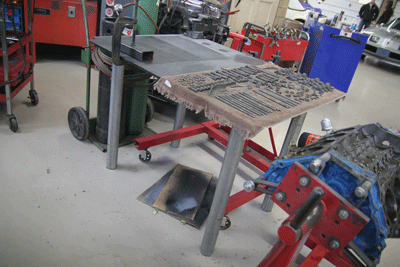
The old welding bench at Zero to 60 Garage has been relegated to parts platform.
Note the reach limitations of the C clamp.
Buying vs. Building
Depending on the model, the "street price" for a basic ArcStation ranges from about $350 to $750; add about $500 more for a table loaded with accessories. Among those with welding and fabrication skills, the initial reaction to buying a third-party welding workbench is almost always includes the statement that, "I can save money building it myself."
However, Wagner explains that this mentality simply isn't true. "As anyone who ever designed something knows, to sit down and draw [table plans], source the material, send an employee across town to buy it, bring it back, cut it up, spend the time welding it all together while that employee could have been billing $70 an hour fixing an old car...it gets very expensive to stop and build a well-designed weld table."
As it relates to raw materials, everyone knows that steel isn't cheap to buy or ship. The material costs for a welding table quickly reach $250 or more:
- A 3/16- or 3/8"-thick plate of steel for the workbench top weighs between 100 and 300 lbs., and steel generally costs $2.00 or more per pound.
- The 1/8" inch square tubing for the legs and cross members (1-1/2" to 2"-diameter) will cost $50 to $75 per 20' length and a table requires 20' to 40'.
- A piece of 14-gauge (3/32") scrap metal for the bottom shelf will suffice, if you can find one. Otherwise, figure about $50.
Time costs add up faster. Even with ready-to-go plans that eliminate design time, a serious welding workbench requires at least 20 hours of labor. This means that building a workbench costs $200 for someone who values his or her time at even $10 an hour. For the high-priced welding talent required by a custom restoration shop, building a welding table in house is a money-losing proposition.
"It's hard to justify time spent building equipment when you can buy something for a reasonable price," states Wagner.
For the DIYer, building a welding table frequently takes one to two entire days, even with a friend helping. Rather than spending a weekend building a workbench, many at-home welders now opt to purchase a welding workbench so they tackle welding projects sooner rather than later, and so they can spend more time off-roading with their friends.
In retrospect, Rounds can't believe he literally suffered for two years without a welding workbench.
"The difference between welding on the floor and using the ArcStation is night and day," he says, noting that knee and back pain are no longer an issue. "Once I started using the ArcStation, I'll never go back to welding on the floor again."
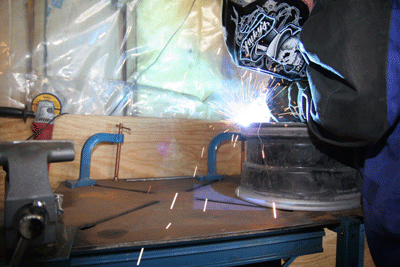
For this welding project, Reon Rounds moved the X clamps to the back of the ArcStation and the vise to a corner.